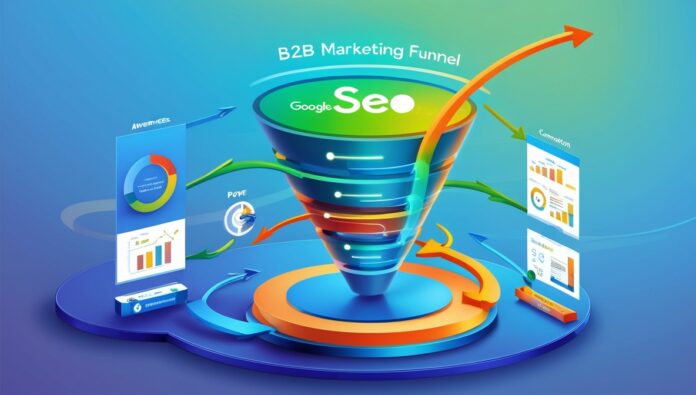Customer journey doesn’t follow a straight line. Buyers explore, compare, and decide on their own terms most often starting with a search. That’s where Google SEO Services becomes a strategic powerhouse. When done right, SEO doesn’t just drive top-of-funnel traffic. It supports every stage of the marketing funnel from generating awareness to converting leads and nurturing loyalty.
This article explores how Google SEO can deliver measurable results across the entire marketing funnel, especially in a B2B context where decision-making cycles are longer, more complex, and more data-driven.
Modern Marketing Funnel
Before diving into SEO’s role, it’s essential to understand how the modern marketing funnel works. While traditional models include the linear stages of Awareness, Consideration, and Decision, digital marketing has evolved this framework to be more dynamic and personalized.
- Top of Funnel (TOFU): At this stage, potential customers become aware of a problem or opportunity. Your goal here is visibility and education.
- Middle of Funnel (MOFU): Here, users compare options and seek solutions. Trust, differentiation, and authority are key.
- Bottom of Funnel (BOFU): Prospects are ready to make a decision. SEO should support conversion and confidence.
SEO’s job isn’t just to rank a few pages—it’s to align your content and site structure with what your audience is searching for at every step of their journey.
Top of Funnel: Building Awareness Through Visibility
Top of Funnel: Building awareness by boosting your brand’s visibility through targeted SEO strategies.
1. Keyword Strategy for Early-Stage Queries
At the awareness stage, your audience is asking broad, exploratory questions. They’re not ready to buy—they’re gathering information. SEO at this level focuses on informational search intent.
Examples:
- “What is cloud ERP software?”
- “How to reduce manufacturing waste”
- “Digital transformation in logistics”
By targeting long-tail, question-based keywords, your brand can show up in early searches and begin the trust-building process.
2. Content Creation That Educates and Engages
Google rewards content that provides value. High-quality blog posts, whitepapers, explainer videos, and infographics optimized for search give users what they need and position your brand as an expert.
SEO Tips:
- Use structured headings with primary and secondary keywords.
- Optimize for featured snippets and People Also Ask boxes.
- Ensure content is mobile-friendly and fast-loading.
3. Authority Building Through Topical Depth
Search engines look for topical authority, especially in B2B industries. You can build this by publishing clusters of content around core themes, interlinking blog posts, and earning backlinks from reputable sources.
Example:
A SaaS company targeting “data compliance” might publish:
- “What Is GDPR Compliance?”
- “HIPAA vs. GDPR: Key Differences”
- “5 Ways to Prepare for a Data Audit”
This content helps you dominate a topic and become the go-to source for early research.
Middle of Funnel: Nurturing Consideration and Trust
Once you’ve captured initial interest, the middle of the funnel is where users actively compare solutions and vendors. SEO must evolve to focus on solution-based content and brand trust.
4. Optimizing Product and Service Pages
Your product and service pages must rank for solution-aware keywords like:
- “Best CRM for small business”
- “Enterprise email encryption tools”
- “Cloud hosting provider comparison”
These pages should go beyond simple feature lists. They must speak to pain points, include social proof, and guide readers toward action.
SEO Strategy:
- Use schema markup for reviews, pricing, and FAQs.
- Include comparison tables and “versus” content.
- Optimize meta titles and descriptions for high CTR.
5. Using SEO to Support Lead Magnets
SEO can drive traffic to gated assets like:
- Case studies
- Webinars
- Industry reports
To make this work, create supporting blog content that ranks and includes strong CTAs to your lead magnets.
Example:
A blog titled “How to Automate Compliance Reporting” could link to a downloadable “Compliance Automation Checklist.”
6. Internal Linking to Guide User Journey
Strategic internal linking keeps users engaged by pointing them to the next relevant step in their research. Use clear anchor text to link TOFU content to MOFU pages.
Example:
- From a blog: “Learn more in our guide to choosing the right CRM for manufacturing teams.”
This approach increases dwell time, improves rankings, and keeps prospects moving through your funnel.
Bottom of Funnel: Driving Conversions with SEO
At the decision stage, users are ready to act—but they need reassurance. SEO should now focus on credibility, clarity, and conversion.
7. Local and Branded Search Optimization
At this stage, users often search for your brand directly:
- “Acme Solutions pricing”
- “Acme Solutions reviews”
- “Acme vs Competitor X”
You need to dominate branded search results and ensure positive, conversion-driven pages are what appear.
Best Practices:
- Optimize “About,” “Pricing,” “Testimonials,” and “Contact” pages.
- Maintain an active Google Business Profile.
- Encourage customer reviews on third-party platforms.
8. Conversion-Focused Landing Pages
Landing pages should be SEO-optimized and designed to convert. Focus on clarity, fast load speed, mobile responsiveness, and keyword-rich H1 tags.
Elements to Include:
- Strong, benefit-driven headlines
- User testimonials
- Trust signals (certifications, client logos, case studies)
- Clear CTA (e.g., “Book a Demo”)
9. Supporting Retargeting and CRO with SEO Data
SEO insights also feed other conversion tactics. Use keyword data and on-site behavior insights to inform:
- Retargeting ad campaigns
- A/B testing hypotheses
- Personalized email nurture sequences
SEO brings the traffic. But pairing it with conversion rate optimization (CRO) multiplies results.
Post-Purchase and Retention: Extending SEO’s Impact
While often overlooked, SEO can also support post-sale loyalty and retention.
10. Support Content That Reduces Churn
Users search for help even after becoming customers. Create and optimize:
- How-to articles
- Knowledge base entries
- Troubleshooting guides
This content improves user experience and reduces customer support costs.
11. Customer-Centric Content for Retention and Upsell
You can also use SEO to surface:
- Product updates
- New features
- Cross-sell opportunities
When current customers search for “how to add users to [Product]” or “custom reports in [Software]”, your content should meet them there.
Why B2B Marketers Must Take SEO Beyond the Top of Funnel
Too many companies treat SEO as a top-of-funnel traffic source only. In reality, Google is present at every stage of the funnel:
- A CMO reads your blog post while researching trends.
- A procurement team compares providers on your product page.
- A CTO evaluates your security practices via your FAQ.
Google SEO doesn’t just fill the funnel—it shapes how buyers perceive your brand at every stage.
Key Takeaways: Making SEO Work Across the Funnel
To recap, here’s how Google SEO supports each stage of the funnel:
| Funnel Stage | SEO Role | Content Types |
| Awareness | Drive visibility for informational searches | Blog posts, guides, explainer videos |
| Consideration | Build trust and position solutions | Product pages, case studies, gated content |
| Decision | Support conversions and credibility | Landing pages, testimonials, comparison pages |
| Post-Purchase | Reduce churn and drive upsell | Help docs, product updates, how-to articles |
Final Thoughts
When executed strategically, Google SEO is not just a traffic tool—it’s a full-funnel growth engine. It captures early-stage interest, guides prospects through evaluation, and drives confident, informed conversions. In B2B, where deals take time and trust matters, SEO is the invisible hand moving your buyers forward—click by click, search by search.
Don’t limit SEO to blog posts and backlinks. Instead, integrate it across your entire marketing strategy and sales funnel. When you optimize for your customer’s journey, not just their keywords, you build a long-term advantage no ad spend can match.




